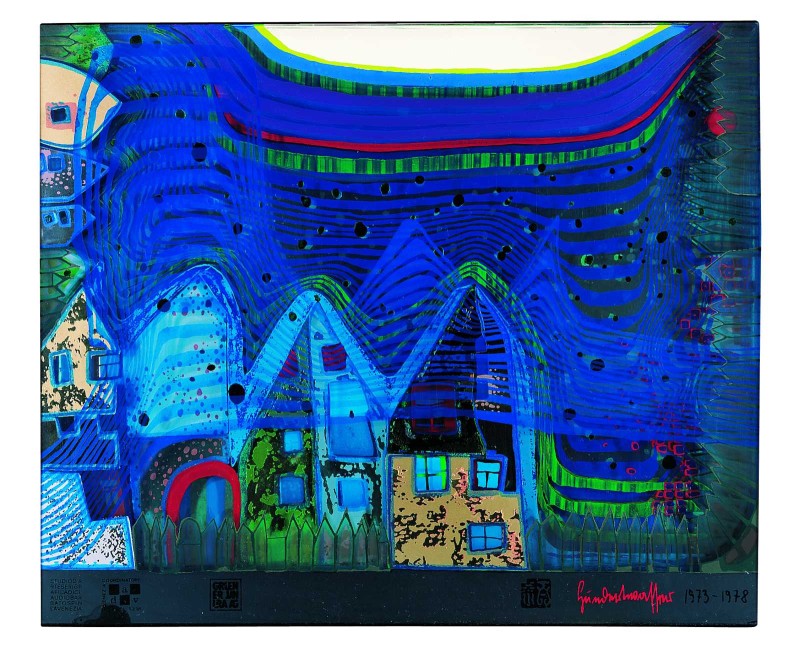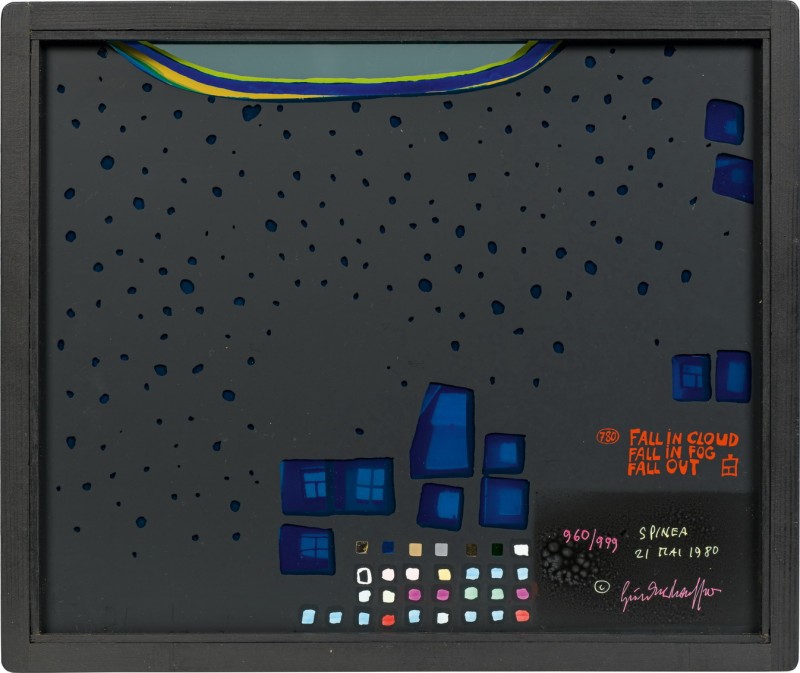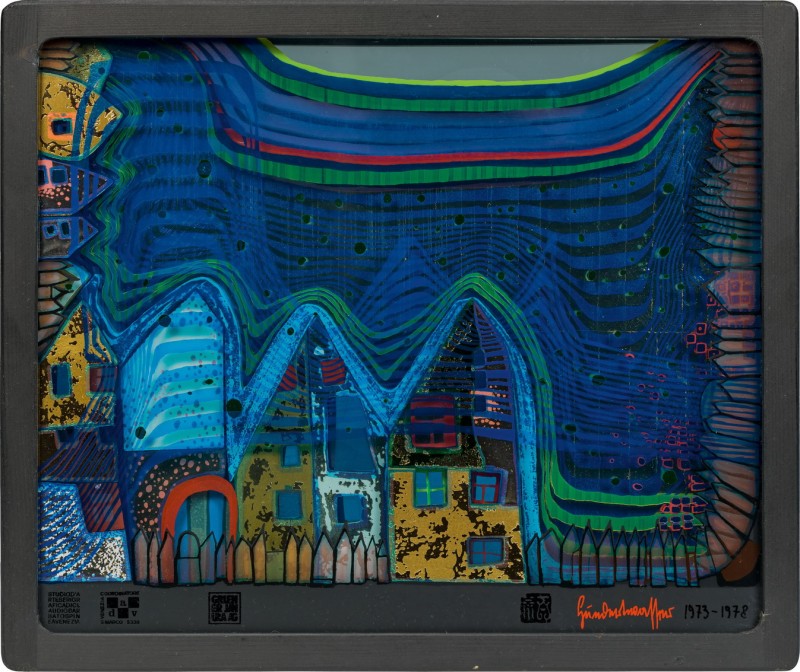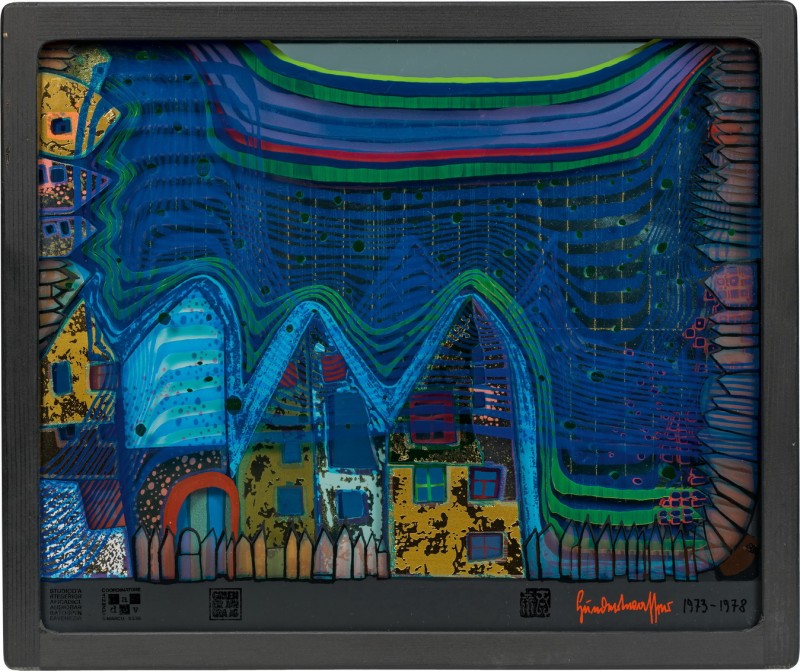Technical research, development and coordination: Alberto della Vecchia, Venice
Acrylic plates: Rimpla, Treviso
Silkscreen printing: Guiseppe Barbato, Venice
Metal embossing: Guiseppe Barbato, Venice
A total of 61 printing runs, comprising 29 with silk screen using 13 colours, and 32 metal embossings in 7 colours
In hand-stained wooden frames
Edition of 999, signed and numbered 1-999/999
On the Development of the 3-Dimensional Object 780 FALL IN CLOUD
FALL IN FOG
FALL OUT
When I was working at a factory in 1973 where Perspex multiples were made for Arman, I was fascinated by the beauty of the material and dreamed of the possibility for Hundertwasser to create a transparent city, shining in every colour and sparkling in colourful metals. The three-dimensional piece is made up of five Perspex panels, called metacrilato in Italian. Later, a panel with a green tint was added in the centre to enhance the distance effect.
When I first had the idea for this "multiplo" in 1973, I knew nothing of the immense difficulties that arose during the realisation.
What seemed so easy to imagine at the beginning, proved increasingly difficult with the first proofs. The usual metal plates could withstand no more than 6 print stages, and the Perspex blocks, which were crystal clear at the outset, became worn and unsightly after 59 print stages. They were no longer transparent and had ugly stripes from the extended manipulation.
There were other difficulties: The Perspex panels are extremely electrostatic. The thickness of a 3 mm plate can vary from 2.25 to 4 mm. Each Perspex panel was layered with 10 to 15 colour silkscreen print stages, in addition to multicoloured metal embossing, executed with a metal embosser bought especially for this project.
It is difficult to produce a conventional silkscreen print in 25 colours as it is. However, supervising the colour harmony and the matching of five transparent panels, each of which constitutes a multicoloured silkscreen print, requires an almost superhuman effort.
Thus after two years of work, the project was discontinued and given up as essentially unfeasible. Later on, when we decided to take up the project once again, we found the plates for the proofs, after extensive searches, in a dog house. The dog was sleeping on them.
Two years of testing were necessary to solve the mirror problem on the last panel alone. When we finally thought we had found the solution with a self-adhesive aluminium foil, it turned out with the first sample package to Vienna that after six months the entire mirror area was blistering.
Hence a different solution had to be found for the mirror. Following further complicated tests, we chose the metal embossing technique on Hundertwasser's suggestion. Since large areas could not be embossed, the mirror was embossed in stripes - in twelve stripes. Since the usual, extremely hard zinc plates were useless for the embossing technique, I finally found silicone rubber on an aluminium support in Milan. Only with this material was it possible to emboss metal on Perspex.
Perspex is a fascinating material, it is transparent like air, with amazing light refraction visible in the prepared Perspex cut.
The biggest problem, which remained unsolved, was the pasting of the Perspex panels. The glue (Tensol) completely bonds the panels together, but when it dries, it produces vapours which dissolve the paints, as well as ugly, glossy areas between the panels which cannot be removed. When 300 objects were already wrapped for shipping, a last check showed that only 28 of 150 specimens were alright. In addition, an entire shipment that had already been received in New York and that had the same problems, had to be replaced by new specimens.
(...)
I drove 600 km in my car, simulating the trip from Venice to Vienna in order to test new packing materials. This material, along with its multiple content, was also flung to the ceiling and down the stairs. In spite of this, a number of multiples which were framed and glued into place in Perspex frames, shattered into a thousand pieces for no apparent reason, and they were not the ones that had been exposed to such rough treatment.
It could only be due to electrostatic tension that arose in the block consisting of five panels glued into the Perspex frame.
It was a new, unsuspected difficulty.
One morning I found three wooden frames in various colours at the Perspex factory in Treviso, which were fitted with multiples, along with a letter by Hundertwasser: "Wooden frames are the solution. Black and green are the colours I want. You can dip the frames into an ink or aniline bath. Then coat with linseed oil and fix with beeswax, thinned down with turpentine and heated up in a water bath. It will be beautiful."
In the end, the five panels were set in the wooden frames without the use of glue. The wood expansion and shrinkage with or against the grain had to be calculated, however, in addition to choosing the wood and colouring the frames. This took months of tests. We decided upon the African abura wood, and on pine and cherry.
Hundertwasser crossed the land bridge La Serenissima from Giudecca to Spinea to see the silkscreen printer a hundred times, and to Treviso to the Perspex factory, to Mestre to see the frame maker, in my car, on a bus, in a taxi, often in heavy fog and in spite of strike barriers. He continued to paint onto the foil, supervised uncountable colour proofs and made corrections.(...)
Seven years have passed since I showed the first Perspex results in a hidden osteria at the Campo Santa Margherita. It was actually a birthday that day, and the enthusiastic admiration of two random young visitors, who were studying the first results with Master Hundertwasser, gave me the conviction that this project would come to a positive conclusion.
Alberto della Vecchia,
Coordinator,
Venice, August 13, 1980
- *
- World Travelling Museum Exhibition:
- *
- *
- *
- Travelling exhibition: Hundertwasser...Die Ausstellung:
- Congresshalle, Saarbrücken, 1999
- Lokschuppen, Rosenheim, 1999/2000
- Bahnhof Uelzen, Uelzen, 2000
- Veranstaltungshalle des Stadtcafé Ottensen, Hamburg, 2001
- Konzert- und Bühnenhaus Kevelaer, Kevelaer, 2002
- Salzstadel, Regensburg, 2003
- Benrather Karree, Dusseldorf, 2003
- Kaufmannshaus, Große Bleichen, Hamburg, 2004
- Ausstellungshalle Pörringer & Schindler, Zweibrücken, 2004
- Ausstellungshalle Nähe Rathaus, Dillingen/Saar, 2005
- Schloss Fachsenfeld, Aalen, 2006
- *
- Travelling exhibition: Sammlung Würth 2004-07:
- Kulturforum Würth, Chur, 2005/06
- Galleri Würth, Hagan, 2006
- Kulturforum Würth, Kolding, 2006/07
- *
- *
- *
- *
- *
- *
- *
- Artcurial, Paris, 1980
- Galerie Peerlings, Krefeld, 1981
- Galerie Dida, Graz, 1981
- Kleine Galerie Pieber, Bernstein, 1981
- Galerie Reinhard Kubias, Emmendingen, 1981
- Galerie Markenbildchen, Koblenz, 1981
- Galerie Trost, Lippstadt, 1981/82
- Lilla Galleriet, Höganäs, 1982
- Galerie Bollhagen, Worpswede, 1986/87
- På Sofiero, Helsingborg, 1988
- Galerie Weihergut, Salzburg, 1992
- Galerie Dida, Graz, 1993
- Galerie am Lindenplatz, Schaan, 1993
- Galerie Krombholz & Schnake, Bergheim, 1993
- Galerie am Stubentor, Vienna, 1993
- Istituto Austriaco di Cultura, Rome, 1994
- Artcurial, Paris, 1996
- Pucker Gallery, Boston, 1996
- Minoritenkloster, Tulln, 2004
- KunstHausWien, Vienna, 2008/09
- Kunstlocatie Würth 's-Hertogenbosch, 2011/12
- ARKEN Museum of Modern Art, Ishoj, Denmark, 2014
- Forum Würth Arlesheim, Switzerland, 2014-17
- Osthaus Museum, Hagen, 2015
- Kurhaus Hinterzarten, 2015
- Pucker Gallery, Boston, 2017
- Musée de Millau et des Grands Causses, Millau, 2018
- Stadtgalerie - Badehaus im Alten Kurpark, 2018
- *
- Secession, Vienna, 1981
- *
- Albertina Travelling Exhibition:
- Städtische Galerie Beethovenhaus, Villingen-Schwenningen, 1980
- Kunstverein Hochrhein, Säckingen, 1980
- Edwin-Scharff-Museum, Neu-Ulm, 1980
- Bayer AG, Leverkusen, 1980
- Kreissparkasse, Heilbronn, 1981
- Neues Rathaus, Weiden, 1981
- Galerie Phönix, Ternitz, 1982
- Palmenhaus Gmünd, 1982
- Galerie im Kornhauskeller, Ulm, 1987/88
- Turmgalerie der Orangerie, Park Sanssouci, Potsdam, 1992
- *
- Travelling exhibition 1985/86:
- Landskonra Museum; Lanskorna, 1985
- Ystad konstmuseum, Ystad, 1985
- Oskarshamns konsthall, Oskarshamn, 1986
- Jönköpings läns museum, Jönköping, 1986
- Sandvikens konsthall, Sandviken, 1986
- Västerbottens museum, Umeå, 1986
- Skaraborgs läns museum, Skara, 1986
- *
- *
- *
- *
- *
- *
- *
- *
- *
- 10th Internat. Art Fair, Basel, 1979
- Schömer-Haus, Klosterneuburg, permanently
- Contemporary Great Masters: Hundertwasser, Tokyo, 1993, pl. 35 (c), p. 112
- Friedensreich Hundertwasser, Frankfurt, 1995, p. 31 (c)
- A. C. Fürst, Hundertwasser 1928-2000, Catalogue Raisonné, Cologne, 2002, Vol. II, pp. 1016-1020 (and c)
- Pucker Gallery, Boston, 1996, cat. 13 (c)
- Die Galerie, Frankfurt, 2001, p. 15 (c)
- Pucker Gallery, Boston, 2003, pp. 11 (c), 21
- Minoritenkloster, Tulln, 2004, p. 82 (c)
- Der unbekannte Hundertwasser, KunstHausWien, Vienna, 2008, pp. 182-184 (and c), 293
- Friedensreich Hundertwasser Graphic Works, Pucker Gallery, Boston, 2017, p. 23 (c, only digital online version)
- Museum Ludwig, Cologne, 1980, pp. 406 (c), 407-411
- Secession, Vienna, 1981, pp. 406 (c), 407-411
- Kulturhaus, Graz, 1981, pp. 406 (c), 407-411
- Barbican Art Gallery, London, 1983, p. 526 (c)
- Travelling exhibition 1985/86: Sweden, cat. 79
- Lokschuppen Rosenheim, 1999, p. 80 (c)
- Congresshalle Saarbrücken, 1999, p. 80 (c)
- Bahnhof Uelzen, Uelzen, 2000, p. 80 (c)
- Veranstaltungshalle des Stadtcafé Ottensen, Hamburg, 2001, p. 58 (c)
- Konzert- und Bühnenhaus Kevelaer, Kevelaer, 2002, p. 74 (c)
- Salzstadel, Regensburg, 2003, p. 74 (c)
- Benrather Karree, Dusseldorf, 2003, p. 74 (c)
- Neue Ausstellungshalle am Rathaus, Dillingen/Saar, 2005, p. 74 (c)
- Schloss Fachsenfeld, Aalen, 2006, p. 74 (c)
- CongressCentrum Böblingen, 2007, p. 74 (c)
- Neustädtisches Palais, Schwerin, 2009, p. 74 (c)
- Leaflet, Forum Würth Arlesheim, 2014 and ed. 2016 (c)
- Pucker Gallery, Boston, 1996, cat. 13 (c)
- Die Galerie, Frankfurt, 2001, p. 15 (c)
- Pucker Gallery, Boston, 2003, pp. 11 (c), 21
- Minoritenkloster, Tulln, 2004, p. 82 (c)
- Der unbekannte Hundertwasser, KunstHausWien, Vienna, 2008, pp. 182-184 (and c), 293
- Friedensreich Hundertwasser Graphic Works, Pucker Gallery, Boston, 2017, p. 23 (c, only digital online version)
- Museum Ludwig, Cologne, 1980, pp. 406 (c), 407-411
- Secession, Vienna, 1981, pp. 406 (c), 407-411
- Kulturhaus, Graz, 1981, pp. 406 (c), 407-411
- Barbican Art Gallery, London, 1983, p. 526 (c)
- Travelling exhibition 1985/86: Sweden, cat. 79
- Lokschuppen Rosenheim, 1999, p. 80 (c)
- Congresshalle Saarbrücken, 1999, p. 80 (c)
- Bahnhof Uelzen, Uelzen, 2000, p. 80 (c)
- Veranstaltungshalle des Stadtcafé Ottensen, Hamburg, 2001, p. 58 (c)
- Konzert- und Bühnenhaus Kevelaer, Kevelaer, 2002, p. 74 (c)
- Salzstadel, Regensburg, 2003, p. 74 (c)
- Benrather Karree, Dusseldorf, 2003, p. 74 (c)
- Neue Ausstellungshalle am Rathaus, Dillingen/Saar, 2005, p. 74 (c)
- Schloss Fachsenfeld, Aalen, 2006, p. 74 (c)
- CongressCentrum Böblingen, 2007, p. 74 (c)
- Neustädtisches Palais, Schwerin, 2009, p. 74 (c)
- Leaflet, Forum Würth Arlesheim, 2014 and ed. 2016 (c)
- Pucker Gallery, Boston, 1996, cat. 13 (c)
- Die Galerie, Frankfurt, 2001, p. 15 (c)
- Pucker Gallery, Boston, 2003, pp. 11 (c), 21
- Minoritenkloster, Tulln, 2004, p. 82 (c)
- Der unbekannte Hundertwasser, KunstHausWien, Vienna, 2008, pp. 182-184 (and c), 293
- Friedensreich Hundertwasser Graphic Works, Pucker Gallery, Boston, 2017, p. 23 (c, only digital online version)
- Museum Ludwig, Cologne, 1980, pp. 406 (c), 407-411
- Secession, Vienna, 1981, pp. 406 (c), 407-411
- Kulturhaus, Graz, 1981, pp. 406 (c), 407-411
- Barbican Art Gallery, London, 1983, p. 526 (c)
- Travelling exhibition 1985/86: Sweden, cat. 79
- Lokschuppen Rosenheim, 1999, p. 80 (c)
- Congresshalle Saarbrücken, 1999, p. 80 (c)
- Bahnhof Uelzen, Uelzen, 2000, p. 80 (c)
- Veranstaltungshalle des Stadtcafé Ottensen, Hamburg, 2001, p. 58 (c)
- Konzert- und Bühnenhaus Kevelaer, Kevelaer, 2002, p. 74 (c)
- Salzstadel, Regensburg, 2003, p. 74 (c)
- Benrather Karree, Dusseldorf, 2003, p. 74 (c)
- Neue Ausstellungshalle am Rathaus, Dillingen/Saar, 2005, p. 74 (c)
- Schloss Fachsenfeld, Aalen, 2006, p. 74 (c)
- CongressCentrum Böblingen, 2007, p. 74 (c)
- Neustädtisches Palais, Schwerin, 2009, p. 74 (c)
- Leaflet, Forum Würth Arlesheim, 2014 and ed. 2016 (c)
- Pucker Gallery, Boston, 1996, cat. 13 (c)
- Die Galerie, Frankfurt, 2001, p. 15 (c)
- Pucker Gallery, Boston, 2003, pp. 11 (c), 21
- Minoritenkloster, Tulln, 2004, p. 82 (c)
- Der unbekannte Hundertwasser, KunstHausWien, Vienna, 2008, pp. 182-184 (and c), 293
- Friedensreich Hundertwasser Graphic Works, Pucker Gallery, Boston, 2017, p. 23 (c, only digital online version)
- Museum Ludwig, Cologne, 1980, pp. 406 (c), 407-411
- Secession, Vienna, 1981, pp. 406 (c), 407-411
- Kulturhaus, Graz, 1981, pp. 406 (c), 407-411
- Barbican Art Gallery, London, 1983, p. 526 (c)
- Travelling exhibition 1985/86: Sweden, cat. 79
- Lokschuppen Rosenheim, 1999, p. 80 (c)
- Congresshalle Saarbrücken, 1999, p. 80 (c)
- Bahnhof Uelzen, Uelzen, 2000, p. 80 (c)
- Veranstaltungshalle des Stadtcafé Ottensen, Hamburg, 2001, p. 58 (c)
- Konzert- und Bühnenhaus Kevelaer, Kevelaer, 2002, p. 74 (c)
- Salzstadel, Regensburg, 2003, p. 74 (c)
- Benrather Karree, Dusseldorf, 2003, p. 74 (c)
- Neue Ausstellungshalle am Rathaus, Dillingen/Saar, 2005, p. 74 (c)
- Schloss Fachsenfeld, Aalen, 2006, p. 74 (c)
- CongressCentrum Böblingen, 2007, p. 74 (c)
- Neustädtisches Palais, Schwerin, 2009, p. 74 (c)
- Leaflet, Forum Würth Arlesheim, 2014 and ed. 2016 (c)
- ARTES, Kunst unserer Welt Nr. 9, Angebotskatalog, Rheda-Wiedenbrück, 1987, p. 278 (c)
- ARTES, Kunst unserer Welt Nr. 20, Angebotskatalog, Rheda-Wiedenbrück, 1998, p. 133 (c)
- J. Windisch, So war's - Ein Rückblick, Vienna, 2007, p. 101 (c)
- Leaflets, project perfect_imperfect, museen basel, Basel, 2013 (c)
- Table mats, project perfect_imperfect, museen basel, Basel, 2013 (c)
- Bilim Cocuk, Ankara, 2015, p. 28 (c)
- Cover of the Compact Disc: Brahms/Valery Afanassiev, Nippon Columbia Co. Ltd., Japan, 1994 (c)
- Cover of the Compact Disc: Brahms/Valery Afanassiev, Nippon Columbia Co. Ltd., Japan, 1994 (c)
- Cover of the Compact Disc: Brahms/Valery Afanassiev, Nippon Columbia Co. Ltd., Japan, 1994 (c)
- Cover of the Compact Disc: Brahms/Valery Afanassiev, Nippon Columbia Co. Ltd., Japan, 1994 (c)





Hundertwasser's comment on the work
I worked for a long time with Alberto Della Vecchia on this Plexiglas seethrough project, based on painting 659 Zwolle. The painting was dismembered in layers, printed individually in silk screen and metallic-stamping technique on several Plexiglas plates, and then re-assembled. It was once again a new technique I had worked out by myself in order to penetrate deeper into paintings. (from: Hundertwasser 1928-2000, Catalogue Raisonné, Vol. 2, Taschen, Cologne, 2002, p. 1019)